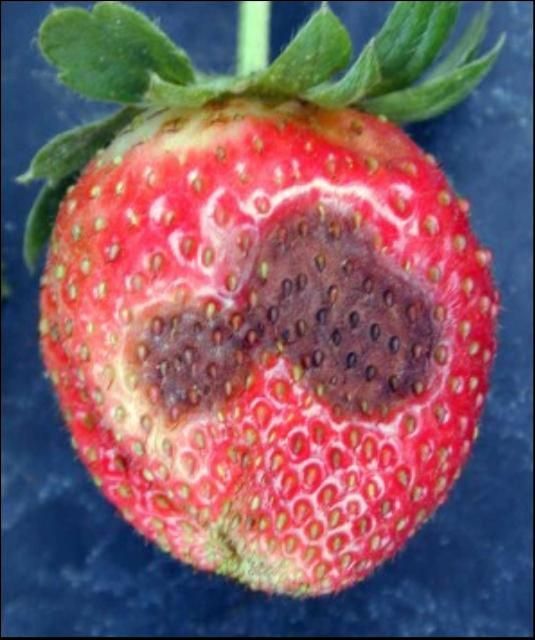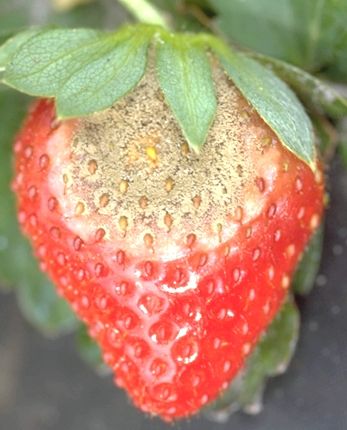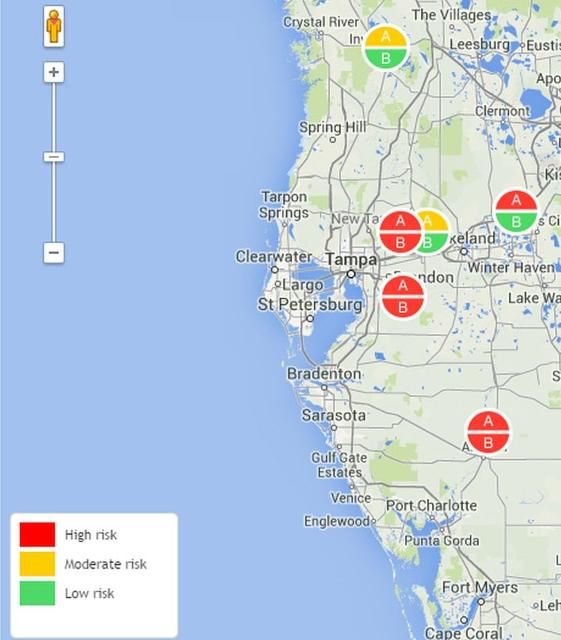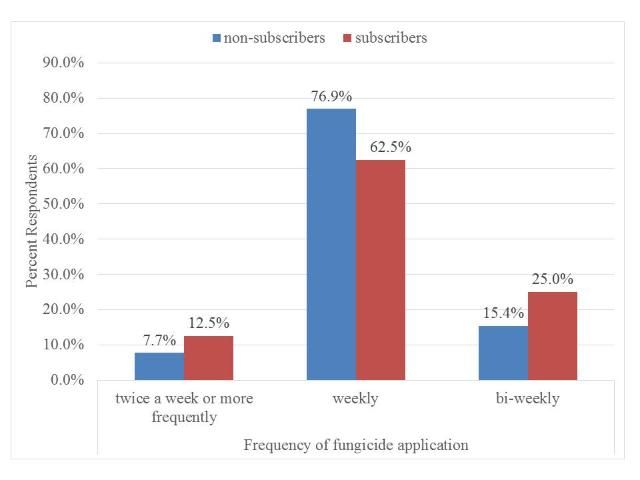Introduction
Florida accounts for 15.6 percent of US strawberry acreage, and it is second after California in total strawberry production volume (USDA/ERS 2013). Anthracnose (Figure 1) and botrytis fruit rot (Figure 2) diseases, which are caused by fungi, can reduce strawberry yields and profits. Florida's producers use fungicides to manage both diseases, which find favorable growth conditions in Florida's climate.


The Strawberry Advisory System (SAS) is an online support system to help strawberry producers evaluate location-specific risk of anthracnose and botrytis fruit rot disease development. SAS uses information about weather conditions and user-entered information about past fungicide applications to evaluate the potential spread of these diseases in strawberry fields. If the potential risk of disease spread is above the defined threshold, fungicide application is recommended. If the potential risk of disease spread is low, no fungicide application is recommended, allowing producers to save on fungicide application costs. The current risk level is displayed online (Figure 3), and fungicide application recommendations are available to subscribers by email or text messages (Pavan et al. 2011; MacKenzie and Peres 2012).

Vorotnikova et al. (2014a) examined data from a UF/IFAS research farm, and showed that SAS-based fungicide application is more profitable than the traditional, calendar-based regular fungicide application for both more- and less-disease-resistant strawberry cultivars. Specifically, this study showed that following the SAS recommendations can potentially bring growers $1.7 million more in net profits over 10 years (Buck 2014). Currently, researchers analyze the data collected from commercial strawberry farms to further evaluate the profitability of SAS (Vorotnikova et al. 2014b).
In 2012, the SAS website was accessed about 3,100 times by over 600 people. Note: this number may include strawberry producers from other states, fungicide distributors, researchers, and interested members of the public. Additional evaluation of the use of SAS among Florida strawberry producers was needed to assess its use within the group.
In this study, we summarize the results of a 2012/2013 survey of strawberry producers, and focus on the following questions:
- How significant is the impact of anthracnose and botrytis on Florida strawberry producers' yields?
- What are the typical fungicide application frequencies used by the producers?
- What percent of strawberry producers use SAS?
- Are there any effects of SAS subscription on producers' fungicide application?
A Survey of Florida Strawberry Producers
In fall 2012 and spring 2013, an industry-wide survey of current strawberry production practices was conducted in Florida. Four questions in the survey were directed toward producers' use of SAS:
- Are you subscribed to receive text or email alerts about anthracnose and/or botrytis risk levels from the AgroClimate Strawberry Advisory System? (Yes/No)
- On average, how frequently do you apply fungicides to control anthracnose and botrytis? (Twice a week or more frequently/Weekly/Biweekly/Once in three weeks or less frequently/Other)
- How frequently are your fields affected by each of the two diseases that cause fruit rot? (Anthracnose: Every year/Every other year/Every 3–4 years/Less frequently than every 4 years. Botrytis: Every year/Every other year/Every 3–4 years/Less frequently than every 4 years)
- When affected by fruit rot, what are the yield losses? (Anthracnose maximum and minimum %; Botrytis maximum and minimum %)
These questions were accompanied by an image of the SAS screen to help producers recall the tool. In addition, the survey instrument included questions about farm characteristics (farm acreage, percent income from strawberry production), as well as socio-demographics of the farm owners/managers (education, age).
The survey instrument was designed by economists and pre-tested with specialists representing other disciplines. There are approximately 100 strawberry producers in Florida, and their contact information was collected from the Gulf Coast Research and Education Center of the University of Florida (UF/GCREC) and local Extension agents. Each of the producers was contacted multiple times by mail. Follow-up interviews were attempted with producers who did not respond to the mail survey.
Of the 100 strawberry farms included in the survey (farm managers or owners were selected as the primary survey respondents), 32 responded to the survey, resulting in a 32 percent response rate. The self-reported total acreage of survey participants was 7,849 acres, or 88.1 percent of total Florida strawberry acreage in 2012.
The Likelihood Ratio Chi-Square, Kolmogorov-Smirnov test, Spearman Correlation Coefficient, and Fisher's exact test were used to analyze the survey responses. The analysis was conducted using SAS© statistical software.
Survey Results
SAS subscription. The majority of respondents (55.2% out of 29 useable responses) reported being subscribed to text or email alerts about anthracnose and botrytis risk levels.
Anthracnose frequency and strawberry losses. Among respondents, 44.9 percent indicated being affected by anthracnose every year; however, the majority (51.7%) stated that their fields are affected by anthracnose every 3–4 years or less frequently. Note that among SAS nonsubscribers, the majority reported getting anthracnose more frequently (every year or every other year) (Figure 4). The difference in the reported anthracnose frequency between SAS subscribers and nonsubscribers was statistically significant (Fisher's exact test, p=0.05). This result may imply that SAS subscription is correlated with other anthracnose management/prevention strategies such as more careful selection of nurseries to reduce the risk of anthracnose occurrence.

When affected by anthracnose, the average producer lost 4–25 percent of the strawberry yield (exception: one producer reported 75% loss of yield). Interestingly, the range of reported losses varied depending on the frequency of fungicide application. While the maximum reported losses were unchanged, the minimum reported losses were smaller for those who reported more frequent fungicide application (Spearman Correlation Coefficient is –0.37, statistically significant at the 95% confidence level). The question can be asked whether the costs of more frequent fungicide application justified for the producers the reduction in minimum (but not the maximum) losses observed.
Botrytis frequency and strawberry losses. Overall, the absolute majority of respondents (96.3%) stated that their fields are affected by botrytis every year. SAS subscription had no statistically significant effect on the reported frequency of botrytis. When affected by botrytis, the average producer lost 5–27 percent of the strawberry yield (exception: one producer reported 85% loss of yield).
Fungicide use. Overall, the majority of respondents (69.0%) applied fungicides weekly to manage anthracnose and botrytis. This application rate is equivalent to the application rate recommended by fungicide labels. The proportion of those who applied fungicides weekly was higher among SAS nonsubscribers (77%) than among SAS subscribers (63%) (Figure 5). While the difference was not statistically significant (Fisher's exact test, p=0.15), this result calls for additional data collection to explore the potential difference.

Conclusions
Based on the results of the 2012/2013 survey of strawberry producers, Florida strawberry producers are generally affected by botrytis fruit rot every year. The occurrence of anthracnose is less predictable, although the disease still affects Florida strawberry producers frequently. When affected by disease, average losses are 4–25 percent of yield for anthracnose and 5–27 percent of yield for boytrytis, although the maximum losses for each of the diseases can be as high as three-fourths of the strawberry yield. Most producers follow fungicide label recommendations, and apply fungicides weekly to manage the diseases.
Given the potentially significant impact of the diseases on yields (and hence profits), the majority of Florida strawberry producers are subscribed to SAS text or email alerts about anthracnose and botrytis risk levels. SAS subscribers tend to report a lower frequency of anthracnose occurrence in their fields, in comparison with nonsubscribers. These differences between subscribers and nonsubscribers imply that SAS is considered to be a useful disease management tool by strawberry producers who already employ a variety of effective strategies to manage anthracnose fruit rot. Finally, survey responses imply that SAS may change the frequency of fungicide application; however, in this study, the data to explore this relationship was insufficient. Additional data should be collected to further explore the possible influence on SAS use on strawberry producers' practices.
References
AgroClimate. 2014. Strawberry Advisory System (SAS). http://agroclimate.org/tools/strawberry/
Buck, B. 2014. UF/IFAS study: Strawberry monitoring system could add $1.7 million over 10 years to some farms. UF/IFAS News, August 5, 2014, https://blogs.ifas.ufl.edu/news/2014/08/05/ufifas-study-strawberry-monitoring-system-could-add-1-7-million-over-10-years-to-some-farms/
MacKenzie, S.J., and N.A. Peres. 2012. Use of leaf wetness and temperature to time fungicide applications to control Anthracnose fruit rot of Strawberry in Florida. Plant Disease 96(4):522–528.
Mertely J.C., and N. A. Peres. 2012. Anthracnose fruit rot of strawberry. #PP207. UF/IFAS Extension, Gainesville, FL. https://edis.ifas.ufl.edu/publication/pp130
Pavan, W., C.W. Fraisse, and N.A. Peres. 2011. Development of a web-based disease forecasting system for strawberries. Computers and Electronics in Agriculture 75:169–175.
UF/IFAS. Undated. Botrytis Fruit Rot/Gray Mold (Botrytis cinerea). http://strawberry.ifas.ufl.edu/plantpathfiles/botrytisfull.htm
USDA/ERS. 2013. U.S. Strawberry Industry (95003). United States Department of Agriculture, Economic Research Service, Washington, D.C. https://usda.library.cornell.edu/concern/publications/8s45q876k?locale=en
Vorotnikova, E., T. Borisova, and J. VanSickle. 2014a. Evaluation of the profitability of a new precision fungicide application system for strawberry production. Agricultural Systems 130(C):77–88. https://econpapers.repec.org/article/eeeagisys/v_3a130_3ay_3a2014_3ai_3ac_3ap_3a77-88.htm
Vorotnikova, E., T. Borisova, J. VanSickle, and N. Peres. 2014b. Risk analysis and producer level impact of the SAS-based. Southern Agricultural Economics Association Conference, Dallas, TX (February). https://ageconsearch.umn.edu/record/162552